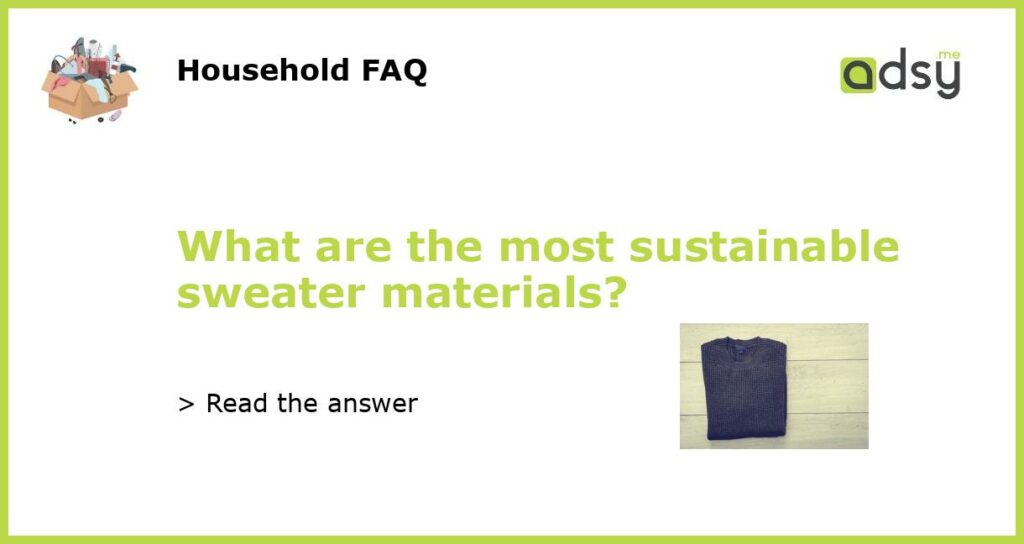Sustainable Sweater Materials: A Guide to Eco-Friendly Fashion
When it comes to choosing sustainable clothing, sweaters are a popular choice. Sweaters not only keep us warm during the cold months but can also make a fashion statement. However, not all sweaters are created equal in terms of sustainability. In this article, we will explore the most sustainable sweater materials, so you can make an informed choice for your wardrobe.
Organic Cotton
Organic cotton is a natural and sustainable choice for sweater materials. Unlike conventional cotton, which is grown using synthetic pesticides and fertilizers, organic cotton is cultivated without any toxic chemicals. This helps to protect the environment, as well as the health of agricultural workers.
By choosing a sweater made from organic cotton, you can support a more sustainable and ethical fashion industry. Look for certifications such as GOTS (Global Organic Textile Standard) to ensure that the cotton used in the sweater meets strict organic standards.
Recycled Polyester
Recycled polyester is another sustainable option for sweater materials. Polyester is a synthetic fabric commonly used in clothing, but it is also a major contributor to plastic pollution due to its non-biodegradable nature. By opting for recycled polyester, you can help reduce the demand for virgin polyester and divert plastic waste from ending up in landfills or oceans.
Recycled polyester is made by melting down existing plastic waste, such as bottles, and then spinning it into new fibers. This process uses significantly less energy and water compared to producing virgin polyester. Look for sweaters made from recycled polyester and check for certifications like the Global Recycle Standard (GRS) to ensure the authenticity of the recycled content.
Hemp
Hemp is an incredibly sustainable material for sweaters. It is a natural fiber that grows quickly and requires minimal water, making it less resource-intensive compared to other natural fibers like cotton. Hemp also has natural anti-bacterial properties, which means it requires fewer chemical treatments during the manufacturing process.
Additionally, hemp cultivation can actually improve the health of the soil, as it replenishes nutrients and prevents soil erosion. Look for sweaters made from organic hemp to ensure minimal environmental impact. Remember, hemp fabric can be a bit coarse initially, but it softens with wear and becomes more comfortable over time.
Tencel (Lyocell)
Tencel, also known as Lyocell, is a sustainable fabric made from the cellulose of sustainably harvested wood pulp. The production process of Tencel has a closed-loop system, which means that the solvents used are recycled, minimizing waste and reducing water consumption.
Not only is Tencel an eco-friendly option, but it also has a soft and luxurious feel, making it a great choice for sweaters. Look for sweaters labeled as Tencel or Lyocell and check for certifications like the Oeko-Tex Standard 100 to ensure that the fabric is free from harmful substances.
Alpaca Wool
Alpaca wool is a sustainable alternative to traditional sheep’s wool. Alpacas have a lower environmental impact compared to sheep, as they require less water and do not contribute to overgrazing. Alpaca wool is also naturally hypoallergenic, making it suitable for those with sensitive skin.
When purchasing alpaca wool sweaters, look for ones made from ethically sourced and responsibly produced alpaca fibers. Opt for small-scale producers or brands that prioritize animal welfare and sustainable practices.
It’s important to note that while these sweater materials are more sustainable than their conventional counterparts, the overall sustainability of a sweater also depends on factors like the production process, dyeing methods, and the brand’s commitment to fair labor practices. Prioritize brands that are dedicated to transparency and environmental responsibility.






